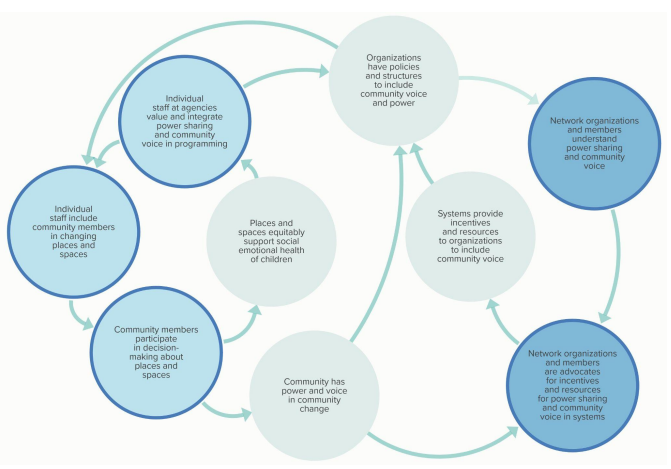
“Evaluate what you want – because what gets measured, gets produced.”
THE INTERVENTION MODEL
The Kaleidoscope Project aims to build the capacity of individuals, organizations, and communities to change systems that perpetuate inequities and create places and spaces that support the social-emotional health of children. While the tangible outcomes of the Kaleidoscope Project’s work are more equitable places and spaces for children and families, the approach focuses on shifting individual mindsets and organizational policies to center community voice in practices and programs. The longer-term impact is a transformation of the system to prioritize community voices and power by providing resources, adjusting accountability measures, and dismantling systemic structures that perpetuate harm. The following diagram illustrates the nature of the system within which the Kaleidoscope Project is working. The outlined circles are areas where the Kaleidoscope Project intervenes to effect change. On the left side of the diagram, the three outlined circles represent the Kaleidoscope Project’s work with its partner organizations and community members or participants in the partner organizations’ programs. The Kaleidoscope Project staff collaborate with individual staff members of organizations and representatives of the community served to improve places and spaces for children. The Kaleidoscope Project’s work not only changes physical spaces but also shifts the mindsets of the partner organizations and the community members. The goal is more organizations sharing power with the people they serve, leading to stronger communities, improved programs, reduced inequities, and increased positive impact. The Kaleidoscope Project piloted this model in 2020-2023, as discussed in detail in Beacon Ridge: A John Rex Endowment Case Study in Community-Based Philanthropy.
Kaleidoscope Project: Description of the Intervention
As the Kaleidoscope Project enters a new phase, the Evaluation Team from Partners for Impact continues to work with Kaleidoscope Project staff to document and understand outcomes and impact. Since the beginning of their partnership with the project, Partners for Impact has taken a developmental approach to the evaluation. The Evaluation Team has gathered qualitative and quantitative data about the activities implemented by the project staff, documented lessons learned, and provided advice to improve and increase the impact of each subsequent phase of the project. In the first year of this phase, the Evaluation Team built a theory of change, a logic model, and an evaluation plan based on lessons learned from prior phases and new directions identified by project staff, the Evaluation Team, John Rex Endowment (JRE) staff, and other consultants. The theory of change is depicted by the diagram on the right. With the hiring of an Advocacy and Communications Coordinator midway through year one, the activities of the Kaleidoscope Project staff have shifted and become more defined. The Advocacy and Communications Coordinator has added new priorities, desired outcomes, and structure to Kaleidoscope Project’s advocacy and networking efforts. The Evaluation Team has been working with the Kaleidoscope Project staff to more fully articulate the intervention design, including activities, outcomes, and impact. This document defines more specifically the multi-pronged intervention of the current phase of the Kaleidoscope


